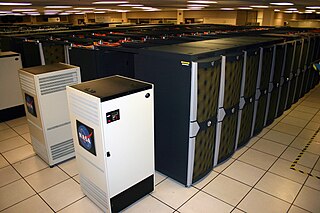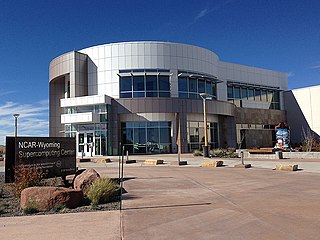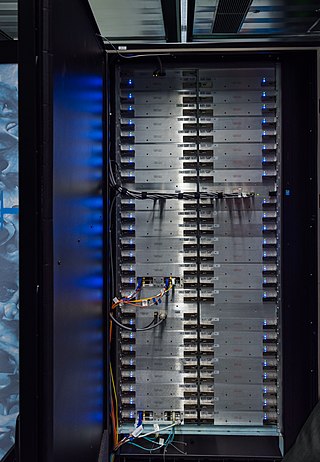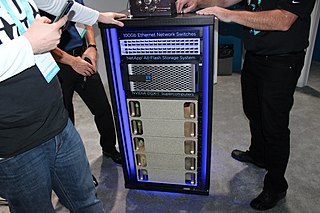Related Research Articles

A supercomputer is a type of computer with a high level of performance as compared to a general-purpose computer. The performance of a supercomputer is commonly measured in floating-point operations per second (FLOPS) instead of million instructions per second (MIPS). Since 2022, supercomputers have existed which can perform over 1018 FLOPS, so called exascale supercomputers. For comparison, a desktop computer has performance in the range of hundreds of gigaFLOPS (1011) to tens of teraFLOPS (1013). Since November 2017, all of the world's fastest 500 supercomputers run on Linux-based operating systems. Additional research is being conducted in the United States, the European Union, Taiwan, Japan, and China to build faster, more powerful and technologically superior exascale supercomputers.

MareNostrum is the main supercomputer in the Barcelona Supercomputing Center. It is the most powerful supercomputer in Spain, one of thirteen supercomputers in the Spanish Supercomputing Network and one of the seven supercomputers of the European infrastructure PRACE.

TeraGrid was an e-Science grid computing infrastructure combining resources at eleven partner sites. The project started in 2001 and operated from 2004 through 2011.
The Texas Advanced Computing Center (TACC) at the University of Texas at Austin, United States, is an advanced computing research center that is based on comprehensive advanced computing resources and supports services to researchers in Texas and across the U.S. The mission of TACC is to enable discoveries that advance science and society through the application of advanced computing technologies. Specializing in high-performance computing, scientific visualization, data analysis and storage systems, software, research and development, and portal interfaces, TACC deploys and operates advanced computational infrastructure to enable the research activities of faculty, staff, and students of UT Austin. TACC also provides consulting, technical documentation, and training to support researchers who use these resources. TACC staff members conduct research and development in applications and algorithms, computing systems design/architecture, and programming tools and environments.
Steele is a supercomputer that was installed at Purdue University on May 5, 2008. The high-performance computing cluster is operated by Information Technology at Purdue (ITaP), the university's central information technology organization. ITaP also operates clusters named Coates built in 2009, Rossmann built in 2010, and Hansen and Carter built in 2011. Steele was the largest campus supercomputer in the Big Ten outside a national center when built. It ranked 104th on the November 2008 TOP500 Supercomputer Sites list.

Pleiades is a petascale supercomputer housed at the NASA Advanced Supercomputing (NAS) facility at NASA's Ames Research Center located at Moffett Field near Mountain View, California. It is maintained by NASA and partners Hewlett Packard Enterprise and Intel.
DiaGrid is a large, multicampus distributed research computing network utilizing the HTCondor system and centered at Purdue University in West Lafayette, Indiana. In 2012, it included nearly 43,000 processors representing 301 teraflops of computing power. DiaGrid received a Campus Technology Innovators Award from Campus Technology magazine and an IDG InfoWorld 100 Award in 2009 and was employed at the SC09 supercomputing conference in Portland, Ore., to capture nearly 150 days of compute time for science jobs.
Clarence Leroy “Ben” Coates was an American computer scientist and engineer known for his work on waveform recognition devices, circuit gates and accumulators.
The National Center for Computational Sciences (NCCS) is a United States Department of Energy (DOE) Leadership Computing Facility that houses the Oak Ridge Leadership Computing Facility (OLCF), a DOE Office of Science User Facility charged with helping researchers solve challenging scientific problems of global interest with a combination of leading high-performance computing (HPC) resources and international expertise in scientific computing.
Coates is a supercomputer installed at Purdue University on July 21, 2009. The high-performance computing cluster is operated by Information Technology at Purdue (ITaP), the university's central information technology organization. ITaP also operates clusters named Steele built in 2008, Rossmann built in 2010, and Hansen and Carter built in 2011. Coates was the largest campus supercomputer in the Big Ten outside a national center when built. It was the first native 10 Gigabit Ethernet (10GigE) cluster to be ranked in the TOP500 and placed 102nd on the June 2010 list.

Tianhe-I, Tianhe-1, or TH-1 is a supercomputer capable of an Rmax of 2.5 peta FLOPS. Located at the National Supercomputing Center of Tianjin, China, it was the fastest computer in the world from October 2010 to June 2011 and was one of the few petascale supercomputers in the world.

Japan operates a number of centers for supercomputing which hold world records in speed, with the K computer being the world's fastest from June 2011 to June 2012, and Fugaku holding the lead from June 2020 until June 2022.

The National Computer Center for Higher Education, based in Montpellier, is a public institution under the supervision of the Ministry of Higher Education and Research (MESR) created by a decree issued in 1999. CINES offers IT services for public research in France. It is one of the major national centers for computing power supply for research in France.

Several centers for supercomputing exist across Europe, and distributed access to them is coordinated by European initiatives to facilitate high-performance computing. One such initiative, the HPC Europa project, fits within the Distributed European Infrastructure for Supercomputing Applications (DEISA), which was formed in 2002 as a consortium of eleven supercomputing centers from seven European countries. Operating within the CORDIS framework, HPC Europa aims to provide access to supercomputers across Europe.

Yellowstone was the inaugural supercomputer at the NCAR-Wyoming Supercomputing Center (NWSC) in Cheyenne, Wyoming. It was installed, tested, and readied for production in the summer of 2012. The Yellowstone supercomputing cluster was decommissioned on December 31, 2017, being replaced by its successor Cheyenne.
Rossmann is a supercomputer at Purdue University that went into production September 1, 2010. The high-performance computing cluster is operated by Information Technology at Purdue (ITaP), the university's central information technology organization. ITaP also operates clusters named Steele built in 2008, Coates built in 2009, Hansen built in the summer of 2011 and Carter built in the fall of 2012 in partnership with Intel. Rossmann ranked 126 on the November 2010 TOP500 list.

The NCAR-Wyoming Supercomputing Center (NWSC) is a high-performance computing (HPC) and data archival facility located in Cheyenne, Wyoming, that provides advanced computing services to researchers in the Earth system sciences.

The Cray XC40 is a massively parallel multiprocessor supercomputer manufactured by Cray. It consists of Intel Haswell Xeon processors, with optional Nvidia Tesla or Intel Xeon Phi accelerators, connected together by Cray's proprietary "Aries" interconnect, stored in air-cooled or liquid-cooled cabinets. The XC series supercomputers are available with the Cray DataWarp applications I/O accelerator technology.

The Nvidia DGX represents a series of servers and workstations designed by Nvidia, primarily geared towards enhancing deep learning applications through the use of general-purpose computing on graphics processing units (GPGPU). These systems typically come in a rackmount format featuring high-performance x86 server CPUs on the motherboard.
The Cheyenne supercomputer at the NCAR-Wyoming Supercomputing Center (NWSC) in Cheyenne, Wyoming operated for seven years as one of the world's most powerful and energy-efficient computers from 2017 to 2024. Ranked in November 2016 as the 20th most powerful computer in the world and November 2023 as 159th by its TOP500 rank, the 5.34-petaflops system is capable of more than triple the amount of scientific computing performed by NCAR's previous supercomputer, Yellowstone. It also is three times more energy efficient than Yellowstone, with a peak computation rate of more than 3 billion calculations per second for every watt of energy consumed.
References
- "Purdue builds nation's fastest campus supercomputer". Purdue University.
- "Purdue names supercomputer after creator of 'Intel Inside'". Purdue University.
- "New Carter cluster is one of the greenest, as well as fastest, in the world". Purdue University.
- Meyer, Leila. "Purdue Builds Top-100 Supercomputer on Unreleased Chips". Campus Technology.
- "Purdue University Builds new HPC cluster with Intel Xeon processor E5-2670". Intel.
- "Dennis Lee Carter". Purdue University.
- "Information Technology at Purdue". Purdue University.
- "Rosen Center for Advanced Computing". Purdue University.
- ↑ "Purdue builds nation's fastest campus supercomputer" (Press release). November 14, 2011.
- ↑ "Purdue's new supercomputer offers more power". Daily Herald (Arlington Heights) . April 12, 2011.
- ↑ "Interview with Dennis Carter". April 20, 2004. Archived from the original on June 26, 2012. Retrieved August 8, 2012.